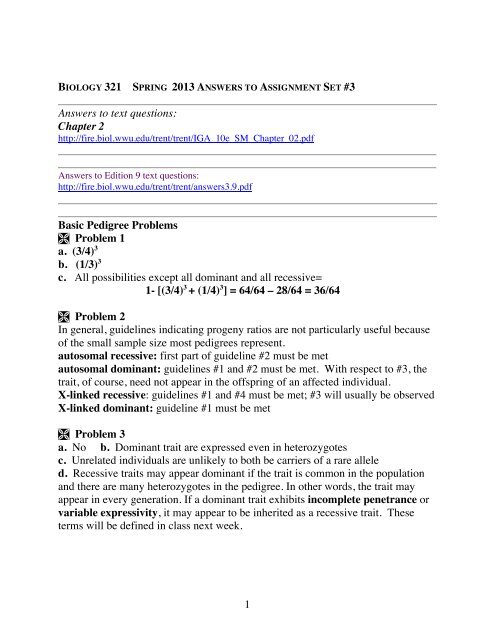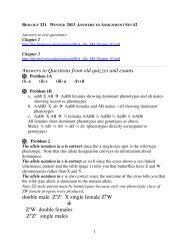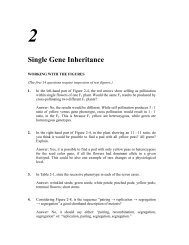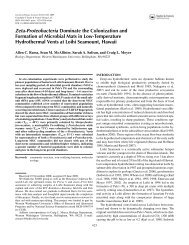Biology 321 Answers to Problem Set 3
Biology 321 Answers to Problem Set 3
Biology 321 Answers to Problem Set 3
Create successful ePaper yourself
Turn your PDF publications into a flip-book with our unique Google optimized e-Paper software.
BIOLOGY <strong>321</strong> SPRING 2013 ANSWERS TO ASSIGNMENT SET #3<br />
<strong>Answers</strong> <strong>to</strong> text questions:<br />
Chapter 2<br />
http://fire.biol.wwu.edu/trent/trent/IGA_10e_SM_Chapter_02.pdf<br />
<strong>Answers</strong> <strong>to</strong> Edition 9 text questions:<br />
http://fire.biol.wwu.edu/trent/trent/answers3.9.pdf<br />
Basic Pedigree <strong>Problem</strong>s<br />
<strong>Problem</strong> 1<br />
a. (3/4) 3<br />
b. (1/3) 3<br />
c. All possibilities except all dominant and all recessive=<br />
1- [(3/4) 3 + (1/4) 3 ] = 64/64 – 28/64 = 36/64<br />
<strong>Problem</strong> 2<br />
In general, guidelines indicating progeny ratios are not particularly useful because<br />
of the small sample size most pedigrees represent.<br />
au<strong>to</strong>somal recessive: first part of guideline #2 must be met<br />
au<strong>to</strong>somal dominant: guidelines #1 and #2 must be met. With respect <strong>to</strong> #3, the<br />
trait, of course, need not appear in the offspring of an affected individual.<br />
X-linked recessive: guidelines #1 and #4 must be met; #3 will usually be observed<br />
X-linked dominant: guideline #1 must be met<br />
<strong>Problem</strong> 3<br />
a. No b. Dominant trait are expressed even in heterozygotes<br />
c. Unrelated individuals are unlikely <strong>to</strong> both be carriers of a rare allele<br />
d. Recessive traits may appear dominant if the trait is common in the population<br />
and there are many heterozygotes in the pedigree. In other words, the trait may<br />
appear in every generation. If a dominant trait exhibits incomplete penetrance or<br />
variable expressivity, it may appear <strong>to</strong> be inherited as a recessive trait. These<br />
terms will be defined in class next week.<br />
1
<strong>Problem</strong> 4<br />
a--excluded: X-linked dominant<br />
if rare: au<strong>to</strong>somal dominant is best answer<br />
b--excluded: nothing is absolutely excluded, but if the trait is rare, au<strong>to</strong>somal<br />
dominant or X-linked dominant are the best answers<br />
c--excluded: X-linked dominant; X-linked or au<strong>to</strong>somal recessive<br />
only possibility: au<strong>to</strong>somal dominant<br />
d--excluded: X-linked or au<strong>to</strong>somal dominant and X-linked recessive<br />
only possibility: au<strong>to</strong>somal recessive<br />
e--excluded: X-linked dominant or au<strong>to</strong>somal dominant<br />
X-linked recessive is best answer, but au<strong>to</strong>somal recessive is possible<br />
f--excluded: au<strong>to</strong>somal dominant and X-linked dominant<br />
if trait is very rare, X-linked recessive is best answer<br />
<strong>Problem</strong> 5 (i) a. (ii) b<br />
<strong>Problem</strong> 6 (i) c. (ii) d<br />
<strong>Problem</strong> 7<br />
__C___ Au<strong>to</strong>somal recessive inheritance of the trait; recessive allele is common in the<br />
population ARC<br />
__E__ Au<strong>to</strong>somal Recessive inheritance (recessive allele is very rare) ARR<br />
__C__ X-linked recessive inheritance (recessive allele is common) XRC<br />
__E__ X-linked dominant inheritance XD<br />
__E__ Au<strong>to</strong>somal Dominant AD<br />
__E__ X-linked dominant; only males show the trait; dominant allele is very rare XDM<br />
__C__ Au<strong>to</strong>somal Dominant and only males show the trait ADM<br />
_E__ Y-linked -- the gene specifying the trait is on the Y chromosome Y<br />
ARR excluded because <strong>to</strong>o many unrelated members of the pedigree would have <strong>to</strong> be het <strong>to</strong><br />
make this pedigree work<br />
XD affected individuals have unaffected parents<br />
AD dit<strong>to</strong><br />
XDM excluded because of male <strong>to</strong> male transmission --unrelated female in second generation<br />
(mother of two affected sons) would have <strong>to</strong> carry the allele<br />
Y -linked excluded because affected males can have unaffected sons and trait is passed via<br />
mother in some generations<br />
<strong>Problem</strong> 8<br />
.__C _ ARR (note inbreeding)<br />
.__C _ ARC<br />
E XRC<br />
E XRD<br />
__C __ AD<br />
2
. The counselor’s was assuming that the trait was au<strong>to</strong>somal dominant. Since neither parent<br />
exhibits the blue trait, they would then be homozygous wildtype and could not produce a blue<br />
child.<br />
c. This trait could be au<strong>to</strong>somal recessive. IN this case, there is a possibility that both parents<br />
are heterozygous since each is in direct descent from an affected individual.<br />
<strong>Problem</strong> 9<br />
E = this mode of inheritance is excluded by the data<br />
C = this mode of inheritance is consistent with the data<br />
__C__Au<strong>to</strong>somal recessive inheritance of the trait; recessive allele is common in the population<br />
ARC<br />
_E___ Au<strong>to</strong>somal Recessive inheritance (recessive allele is very rare) ARR<br />
_E___ X-linked recessive inheritance (recessive allele is common) XRC<br />
_E___ X-linked recessive inheritance (recessive allele is very rare) XRR<br />
_E___ X-linked dominant inheritance XD<br />
_C___ Au<strong>to</strong>somal dominant inheritance AD<br />
<strong>Problem</strong> 10<br />
• NOTE: the easiest way <strong>to</strong> work this problem is <strong>to</strong> figure out all possibilities except 2:2<br />
and then subtract the sum of all these other possibilities from 1. BUT, the weakness in<br />
this approach is that if you have made a mistake in one of the other calculations, your<br />
answer for 2:2 will be wrong as well.<br />
• Alternatively, for 2:2, figure out all possible sibships (birth orders) of 2 affected and 2<br />
unaffected. You can figure this out by trial and error OR (OPTIONAL) learn <strong>to</strong> use the<br />
appropriate mathematical <strong>to</strong>ol (the binomial) at this site:<br />
http://www.stat.yale.edu/Courses/1997-98/101/binom.htm<br />
dominant recessive probability<br />
4 0 (3/4) 4 81/256<br />
3 1 4 (3/4) 3 (1/4) 108/256 = 42%<br />
2 2 6 (3/4) 2 (1/4) 2 54/256<br />
1 3 4 (3/4) 1 (1/4) 3 12/256<br />
0 4 (1/4) 4 1/256<br />
<strong>Problem</strong> 11 See class discussion<br />
<strong>Problem</strong> 12<br />
a. probability that groom is het = 1 probability bride is het = 2/3 X1/2 = 1/3<br />
both het = 1 X 1/3 = 1/3<br />
b. probability that neither are het = 0 since groom has <strong>to</strong> be het<br />
probability that one is het and the other homozygous = 1-(1/3) = 2/3<br />
or another way <strong>to</strong> think about it: probability that groom is het = 1<br />
probability bride is not het = 1 -(1/3) = 2/3<br />
c. 1 (probability groom is het) X 1 X 10 -3 X ¼ = 1 x 1/1000 X ¼ = 1 in 4000<br />
3






